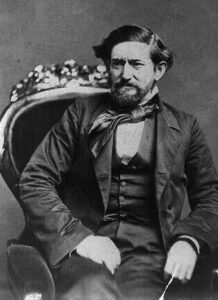
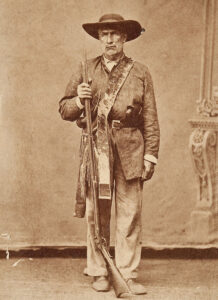 William Alexander Anderson Wallace was born in Lexington, Virginia on April 3, 1817, parents of Scots-Irish descent. He might have stayed in Virginia, but in 1836, when he was just 19 years old, Wallace received news that one of his brothers had been killed in the Battle of Goliad, which was an early confrontation in the Texan war of independence with Mexico. Wallace promised to “take pay of the Mexicans” for his brother’s death. So, with revenge on his mind, Wallace left Lexington and headed for Texas. Upon his arrival, Wallace found that the war was already over. With no further need of his anger-revenge agenda, Wallace found he liked the spirited independence of the new Republic of Texas and decided to stay.
William Alexander Anderson Wallace was born in Lexington, Virginia on April 3, 1817, parents of Scots-Irish descent. He might have stayed in Virginia, but in 1836, when he was just 19 years old, Wallace received news that one of his brothers had been killed in the Battle of Goliad, which was an early confrontation in the Texan war of independence with Mexico. Wallace promised to “take pay of the Mexicans” for his brother’s death. So, with revenge on his mind, Wallace left Lexington and headed for Texas. Upon his arrival, Wallace found that the war was already over. With no further need of his anger-revenge agenda, Wallace found he liked the spirited independence of the new Republic of Texas and decided to stay.
Wallace was a big man, standing over six feet tall and weighing around 240 pounds. His size alone made him an intimidating figure, but his nickname of “Big Foot” came from his unusually large feet. Wallace didn’t think he would ever get the chance to fight Mexicans, but in 1842, he finally got his chance when he joined with other Texans to stop an invasion by the Mexican General Adrian Woll. During another skirmish with Mexicans, Wallace was captured, and he spent the next two years serving hard time in the notoriously brutal Perote Prison in Vera Cruz. He was finally released in 1844.
After his time as a prisoner of war, Wallace returned to Texas and found himself feeling tired of the rigidness of the formal Texan military force. So, he decided to leave the military for the less rigid organization of the Texas Rangers. The Texas Ranger program was part law-enforcement officers and part soldiers. They fought both bandits and Native Americans in the large, but sparsely populated reaches of the Texan frontier. “Big Foot” Williams served under the famous Ranger John Coffee Hays until the start of the Civil War in 1861. Williams was against the idea of Texas secession from the Union, but he was unwilling to fight against his own people. He had really assimilated himself into Texas…it was a big part of him. Williams spent most of the Civil War defending Texas against Native American attacks along the frontier. He didn’t get involved in the “politics” of the matter, he just knew that he was now a Texan, and he had to defend her at all costs.
Wallace spent many years in the wilds of Texas, having hundreds of adventures. He was attacked by Native Americans while working as a stage driver on the dangerous San Antonio-El Paso route. In that event, he 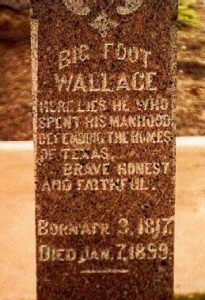
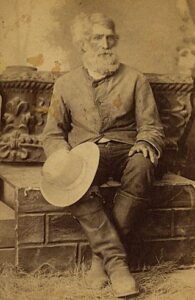 barely escaped with his life. The Natives stole his mules and left him stranded in the Texas desert. Forced to walk all the way to El Paso, he later said that he ate 27 eggs at the first house he came to after his long walk. Then, he went into town to have a “real meal.”
barely escaped with his life. The Natives stole his mules and left him stranded in the Texas desert. Forced to walk all the way to El Paso, he later said that he ate 27 eggs at the first house he came to after his long walk. Then, he went into town to have a “real meal.”
After many years and many adventures and in his old age, Wallace decided he had enough of life as a fighter and adventurer. He was tired and ready to learn how to relax. The state of Texas, in exchange for his years of service, granted Wallace land along the Medina River and in Frio County in the southern part of the state. Wallace loved to tell anyone who would listen, with highly embellished tales of his frontier days. Soon he became a well-known folk hero to the people of Texas. Wallace died on January 7, 1899. He is buried in the Texas State Cemetery.
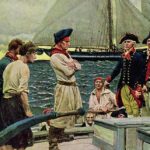
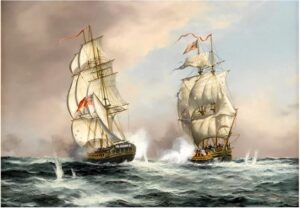 During the Revolutionary War, the United States, being a small start-up nation did not have huge amounts of funds to build a strong navy to fight against the influx of British ships sent to try to force our nation back under the rule of Great Britain, so being the resourceful nation they were, the Continental Congress made the decision to give privateers permission to attack any and all British ships on April 3, 1776. The bill was signed by John Hancock, president of the Continental Congress at that time. The bill issued “INSTRUCTIONS to the COMMANDERS of Private Ships or vessels of War, which shall have Commissions of Letters of Marque and Reprisal, authorizing them to make Captures of British Vessels and Cargoes.”
During the Revolutionary War, the United States, being a small start-up nation did not have huge amounts of funds to build a strong navy to fight against the influx of British ships sent to try to force our nation back under the rule of Great Britain, so being the resourceful nation they were, the Continental Congress made the decision to give privateers permission to attack any and all British ships on April 3, 1776. The bill was signed by John Hancock, president of the Continental Congress at that time. The bill issued “INSTRUCTIONS to the COMMANDERS of Private Ships or vessels of War, which shall have Commissions of Letters of Marque and Reprisal, authorizing them to make Captures of British Vessels and Cargoes.”
The private commercial ships were given “Letters of Marque and Reprisal” which were the official documents by which 18th-century governments commissioned private commercial ships, known as privateers, to act on their behalf. With these documents, they were officially allowed to start attacking ships carrying the flags of enemy nations. The motivation for the “assignments” was that any goods captured by the privateer were to be divided between the ship’s owner and the government that had issued the letter. It was a pretty good deal for the privateer, because they could then sell or use the good, or sell them for a profit. It was also a good deal for the government, because the received half of the “spoils” and they didn’t have to pay the privateer. As for the British ships…well, the deal was not so good.
The orders given to the privateers by Congress were “YOU may, by Force of Arms, attack, subdue, and take all Ships and other Vessels belonging to the Inhabitants of Great Britain, on the high seas, or between high-water and low-water Marks, except Ships and Vessels bringing Persons who intend to settle and reside in the United Colonies, or bringing Arms, Ammunition or Warlike Stores to the said Colonies, for the Use of such Inhabitants thereof as are Friends to the American Cause, which you shall suffer to pass unmolested, the Commanders thereof permitting a peaceable Search, and giving satisfactory Information of the Contents of the Ladings, and Destinations of the Voyages.”
The reality was that whether they were called privateers or pirates, the real distinction between the two was non-existent, at least to those who faced them on the high seas. The men were given the right to behave just 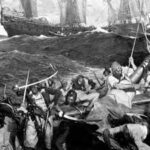
 like pirates, so they behaved just like pirates, boarding and capturing ships and using force if necessary. The good news for the privateers was that privateers holding Letters of Marque were not subject to prosecution by their home nation and, if captured, were treated as prisoners of war instead of criminals by foreign nations. Even if they were caught, this was the best-case scenario for the privateers, and they were the best thing for this country at that important time in our history.
like pirates, so they behaved just like pirates, boarding and capturing ships and using force if necessary. The good news for the privateers was that privateers holding Letters of Marque were not subject to prosecution by their home nation and, if captured, were treated as prisoners of war instead of criminals by foreign nations. Even if they were caught, this was the best-case scenario for the privateers, and they were the best thing for this country at that important time in our history.
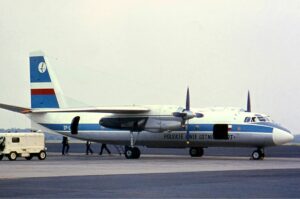
 LOT Polish Airlines Flight 165 was a doomed Antonov AN-24 aircraft, registration SP-LTF. The plane operated as a scheduled passenger flight from Warsaw to Krakow Balice airport. Normally the 153-mile flight is a simple short hop, but on April 2, 1969, at 4:08pm local time the flight crashed into a mountain during a snowstorm. All 53 people on board were killed.
LOT Polish Airlines Flight 165 was a doomed Antonov AN-24 aircraft, registration SP-LTF. The plane operated as a scheduled passenger flight from Warsaw to Krakow Balice airport. Normally the 153-mile flight is a simple short hop, but on April 2, 1969, at 4:08pm local time the flight crashed into a mountain during a snowstorm. All 53 people on board were killed.
In 1969, crash investigation was not what it is today, and so a lot of the known information about the accident actually comes from two newspaper articles that were published in 1994. Of course, that doesn’t mean that no investigation took place, but from the sound of things, the documentation there has been kept classified according to the author who wrote that, “even 25 years after the accident, most documentation on the crash remains classified.” The information the author was able to gather came from the accounts of participants in the rescue action and some members of the accident investigation commission, but they asked for anonymity.
What is known and documented about the accident is that the aircraft took off from Warsaw at 3:20pm local time for a 55-minute flight to Krakow’s Balice Airport. The captain was Czeslaw Dolinski. The first officer received instructions at 3:49pm, to descend to 4,900 feet and to contact Balice control tower after passing Jedrzejów, which was less than 50 miles north of Krakow. At the time of the instructions, a military radar registered the aircraft at 13,000 feet. The pilots informed controllers in Okecie and Balice when the plane had passed the Jedrzejów VOR but there was some confusion when they provided three different passage times a few minutes apart. Shortly thereafter and before 4:00pm, the captain, who had taken over control at that point, called Balice. Dolinski gave his altitude as 12,100 feet, received the local weather report, and then was instructed to descend to 3,900 feet.
At 4:01pm, the aircraft was recorded at 7,900 feet and descending. Several radio exchanges took place between the place and the Balice radar operator over the next eight minutes, with the captain repeatedly asking for his fix and reporting problems with the beacon signal, and the operator asking for the aircraft’s position and altitude to help him find the aircraft on the radar screen. It was as if both the captain and the radar operator were confused as to where the plane was and at what altitude. At 4:05pm, the aircraft was noted near Maków Podhalanski, some 31 miles past Krakow…and at an altitude of 3,900 feet. The last transmission received from the airplane was, “Left turn to further…-” at 4:08.17pm. Seconds after that, radio contact was lost. It was at that moment that the plane crashed on the northern slope of Polica mountain, near Zawoja, southern Poland. the plane was located on the mountain side at an altitude of 3,900 feet.
The official death toll of 53 is still in question. The LOT Flight 165 manifest included 53 passengers and 5 crew members, but two days after the crash Polish press agencies published, 46 surnames, some without an address or name. According to the records, the passengers were 49 Poles, 3 Americans, and a Briton. The official 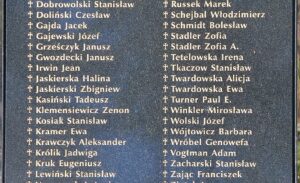
 accident report, published in 1970, blamed the accident on the captain becoming lost. No one knew why the captain, just before the crash, was flying at low altitude some 31 miles past its intended destination. I don’t suppose it will ever be known for sure, or if it is, the fact that the documentation is classified will keep the truth from everyone anyway.
accident report, published in 1970, blamed the accident on the captain becoming lost. No one knew why the captain, just before the crash, was flying at low altitude some 31 miles past its intended destination. I don’t suppose it will ever be known for sure, or if it is, the fact that the documentation is classified will keep the truth from everyone anyway.

 Whether you or I prank anyone on this day makes no difference. This is the day for it. Why would anyone think that we need a day to be set aside whereby it was perfectly “legal” to play multiple tricks on people? Maybe they thought that after a long dreary winter, we needed a day to just get silly. Sounds good to me. I love a good prank as much as the next guy. I can’t say that I have always been good at pranking, and I can’t say some pranks haven’t blown up in my face…apparently not everyone likes to be pranked. Go figure!! I think for me is stems from my childhood years when my sisters and I tried to pull every April Fools’ Day joke we could think of on friends or family who happened to cross our paths.
Whether you or I prank anyone on this day makes no difference. This is the day for it. Why would anyone think that we need a day to be set aside whereby it was perfectly “legal” to play multiple tricks on people? Maybe they thought that after a long dreary winter, we needed a day to just get silly. Sounds good to me. I love a good prank as much as the next guy. I can’t say that I have always been good at pranking, and I can’t say some pranks haven’t blown up in my face…apparently not everyone likes to be pranked. Go figure!! I think for me is stems from my childhood years when my sisters and I tried to pull every April Fools’ Day joke we could think of on friends or family who happened to cross our paths.
While many possible origins for the national prank day exist, no one truly seems to know where or when it started. Maybe the origins story is a joke in its own right. It could be that whenever and wherever it got started, the initiator decided to say that the tradition started somewhere else so that they could say that they were just following the tradition they had heard about. That idea isn’t so farfetched, now, is it? Somebody, somewhere had to get this started. Still, maybe for those who don’t like being pranked, the originator didn’t want to take the blame. That makes sense to me too. If you have ever been “that guy” who pranked someone with no sense of humor, you know that you would gladly blame someone else…anyone else for making you do such a thing.
I’m just thankful that it was a tradition in our family…from our parents, Al and Collene Spencer, all the way down to my sisters, Cheryl Masterson, Caryl Reed, Alena Stevens, and Allyn Hadlock…and then on to the 
 generations beyond. People really should be taught at a young age to take a joke, and even to laugh at ourselves when we’ve been had. It’s a well-known fact, even from the Bible…Proverbs 17:22, “Laughter is like taking good medicine.” It is true, and even medicine has agreed that laughter is good for you. Laughter reduces stress, strengthens the immune system, boosts mood, and diminishes pain…just to name a few good things about laughter. So, for all you people who have no sense of humor…lighten up and laugh a little. You know you want to!! Happy April Fools’ Day everyone!!
generations beyond. People really should be taught at a young age to take a joke, and even to laugh at ourselves when we’ve been had. It’s a well-known fact, even from the Bible…Proverbs 17:22, “Laughter is like taking good medicine.” It is true, and even medicine has agreed that laughter is good for you. Laughter reduces stress, strengthens the immune system, boosts mood, and diminishes pain…just to name a few good things about laughter. So, for all you people who have no sense of humor…lighten up and laugh a little. You know you want to!! Happy April Fools’ Day everyone!!

 My niece, Liz Masterson is a Journalism and English teacher at Kelly Walsh High School, where she also attended high school. I think it’s very cool that she is teaching at her Alma Mater. I know she likes it too. Liz also takes most of the photographs of events for the annual, as well as producing it with her students. Her work makes the annual an outstanding book that is cherished by all who purchase it. She has also taken a lot of the senior pictures for various students. Her creativity makes each set of photographs amazing memories for the students. Being a teacher keeps Liz very busy, and there are several times during the year that we almost don’t see her, because she runs from this event to that event and back to school, and of course home to grade papers and choose pictures for her work on the annual.
My niece, Liz Masterson is a Journalism and English teacher at Kelly Walsh High School, where she also attended high school. I think it’s very cool that she is teaching at her Alma Mater. I know she likes it too. Liz also takes most of the photographs of events for the annual, as well as producing it with her students. Her work makes the annual an outstanding book that is cherished by all who purchase it. She has also taken a lot of the senior pictures for various students. Her creativity makes each set of photographs amazing memories for the students. Being a teacher keeps Liz very busy, and there are several times during the year that we almost don’t see her, because she runs from this event to that event and back to school, and of course home to grade papers and choose pictures for her work on the annual.


Her busy schedule makes any school vacation time precious to Liz. She loves to travel and often hooks up with friends for trips that make her time off very special. This past week was Spring Break, so Liz and a friend headed down to Las Vegas to have a little fun and sun, as well as to attend a concert of Liz’s favorite artist, Carrie Underwood. Liz has loved Carrie Underwood’s music she he first came on the scene, and she is always invited to the fan appreciation events, which she tries to get to as often as she can. Having the concert be in Vegas was just icing on the cake for Liz. She and her friend also hooked up with a former student who had just finished grad school. It was a fun time for all three of the girls.
Liz has always stayed in touch with many of her former students. She is a favorite of many of her current and 
 former students. She has taken their school event pictures, senior pictures, and gone on to take their wedding pictures. It’s not every teacher that you want to remember for years after school ends, much less to stay in touch with, but Liz is that rare teacher who has managed to be a great influence on her students, and they want to remember her always. She helped to prepare them for their college studies and given them a work ethic that has made them great members of society, so it makes perfect sense that they would want her to share in their wedding joy. A teacher like Liz is a rare find, and anyone who had her for a teacher is truly blessed. We all consider ourselves blessed to know Liz. Today is Liz’s birthday. Happy birthday Liz!! Have a great day!! We love you!!
former students. She has taken their school event pictures, senior pictures, and gone on to take their wedding pictures. It’s not every teacher that you want to remember for years after school ends, much less to stay in touch with, but Liz is that rare teacher who has managed to be a great influence on her students, and they want to remember her always. She helped to prepare them for their college studies and given them a work ethic that has made them great members of society, so it makes perfect sense that they would want her to share in their wedding joy. A teacher like Liz is a rare find, and anyone who had her for a teacher is truly blessed. We all consider ourselves blessed to know Liz. Today is Liz’s birthday. Happy birthday Liz!! Have a great day!! We love you!!
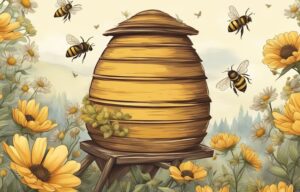 In a long-standing Western European tradition, the bees must be told of important events in the lives of their owners. Things such as deaths, births, marriages, and departures and returns in the keeper’s household. It is believed that the bees need to go through a mourning process to keep them emotionally healthy. If this practice was omitted or forgotten, and the bees were not “put into mourning,” then it was believed a penalty would be paid, such as the bees leaving their hive, stopping the production of honey, or even dying. Such a thing seems strange to anyone who has never had anything to do with bees, but who knows. Maybe they know, just like a dog or a cat knows their owner is gone. Best known in England, the practice has also been recorded in Ireland, Wales, Germany, Netherlands, France, Switzerland, Bohemia (now Czechia) and the United States.
In a long-standing Western European tradition, the bees must be told of important events in the lives of their owners. Things such as deaths, births, marriages, and departures and returns in the keeper’s household. It is believed that the bees need to go through a mourning process to keep them emotionally healthy. If this practice was omitted or forgotten, and the bees were not “put into mourning,” then it was believed a penalty would be paid, such as the bees leaving their hive, stopping the production of honey, or even dying. Such a thing seems strange to anyone who has never had anything to do with bees, but who knows. Maybe they know, just like a dog or a cat knows their owner is gone. Best known in England, the practice has also been recorded in Ireland, Wales, Germany, Netherlands, France, Switzerland, Bohemia (now Czechia) and the United States.
It is unknown how this practice got started, or where it stared exactly, but unfounded speculation has it that it 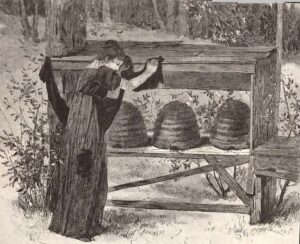 is loosely derived from or perhaps inspired by ancient Aegean notions about bees’ ability to bridge the natural world and the afterlife. There were many notions that people of ancient times believed, so I suppose this could be one of them.
is loosely derived from or perhaps inspired by ancient Aegean notions about bees’ ability to bridge the natural world and the afterlife. There were many notions that people of ancient times believed, so I suppose this could be one of them.
The whole practice has a number of strange parts to it and probably came from superstition. Apparently, it is tradition to give a piece of wedding cake or a funeral biscuit to the bees at wedding and funerals. This is done to inform the bees at the same time of the name of the party married or dead. Apparently, if the bees do not know about the marriage, they become very irate, and sting everybody within their reach. If they are ignorant of the death, they become sick, and many of them die. That might possibly speak to something similar to a pet losing its master. In the case of a death, it would inform them of a new owner. Again, this reminds me of a pet mourning an owner, even when they are shown love by the new owner. Animals can show love, maybe bees can too.
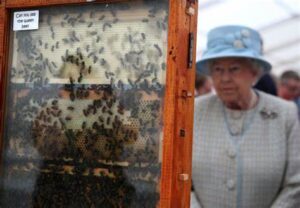
The practice even extends to the royal family. After the passing of Britain’s Queen Elizabeth II in 2022, the Royal Beekeeper, John Chapple, went out to inform the bees of Buckingham Palace and Clarence House of her passing and the accession of King Charles III. There is a proper process for informing the bees. According to Chapple, “You knock on each hive and say, “The mistress is dead, but don’t you go. Your master will be a good master to you.” Often the hive is also given a black sash for mourning. The purpose of all this is to ensure the health of the bees and the continuation of their honey production. It’s a strange, but interesting tradition.
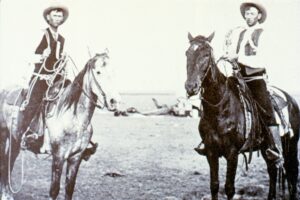 As the ranchers opened up the American West, they became some of America’s elite citizens. Their ranches soon became the target of criminals looking to make easy money. Of course, the ranchers had more than just their reputations…they had money and influence, and when their cattle started going missing, they were going to have their revenge. Cattle rustling was considered a serious offense in the American West and, in some cases, resulted in vigilantes hanging or shooting the thieves. Tempers always ran hot when these criminals were caught. While the ranchers were rich, they still worked just as hard for their money as anyone else.
As the ranchers opened up the American West, they became some of America’s elite citizens. Their ranches soon became the target of criminals looking to make easy money. Of course, the ranchers had more than just their reputations…they had money and influence, and when their cattle started going missing, they were going to have their revenge. Cattle rustling was considered a serious offense in the American West and, in some cases, resulted in vigilantes hanging or shooting the thieves. Tempers always ran hot when these criminals were caught. While the ranchers were rich, they still worked just as hard for their money as anyone else.
During the Civil War, Mexican cattle rustlers were a major issue. As with crimes across our southern border today, the Mexican government was accused of supporting the habit of cattle rustling. Of course, Mexican rustlers weren’t alone in their crimes. American rustlers also stole Mexican cattle from across the border, and  the reality is that not every rustler was from Mexico. The United States had its share of thieves too. One prime target was unbranded new calves. When ranchers failed to brand new calves, it facilitated theft. Unbranded calves were very hard to track, and their theft was difficult to prove. Of course, cattle could be stolen out of necessity, or by the Indians, but while that is technically rustling, it could be looked at somewhat differently. Not that it really ever was. Cattle rustling was cattle rustling, and that was all there was to it.
the reality is that not every rustler was from Mexico. The United States had its share of thieves too. One prime target was unbranded new calves. When ranchers failed to brand new calves, it facilitated theft. Unbranded calves were very hard to track, and their theft was difficult to prove. Of course, cattle could be stolen out of necessity, or by the Indians, but while that is technically rustling, it could be looked at somewhat differently. Not that it really ever was. Cattle rustling was cattle rustling, and that was all there was to it.
Conflict over alleged rustling was a major issue in the Johnson County War of 1892 in Wyoming. The conflict began when cattle companies began persecuting alleged rustlers in the area, many of whom were settlers who competed with them for livestock, land, and water rights. As the violence swelled between the large established ranchers and the smaller settlers in the state, it culminated in the Powder River Country, when the ranchers decided to hire gunmen to invade the county. This was the beginning of vigilantes when it came to cattle rustling. They were ruthless, and they spared no one who was thought to be a rustler.
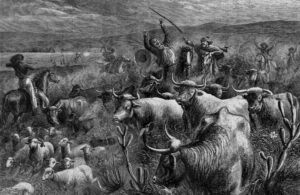
When the ranchers transitioned from open range to fenced grazing, cattle rustling gradually declined in North America. In the 20th century, A different kind of rustling emerged…often called suburban rustling, the practice involved rustlers anesthetizing the cattle and then taking them directly to auction. This eliminated the need to storing the cattle. The practice usually takes place at night, which makes detection difficult for law enforcement. On large ranches, it can take several days for the loss of cattle to be noticed and reported. for that reason, convictions are extremely rare, and even nonexistent.
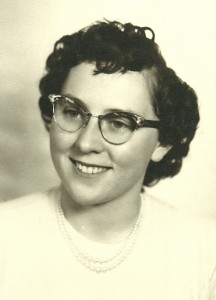
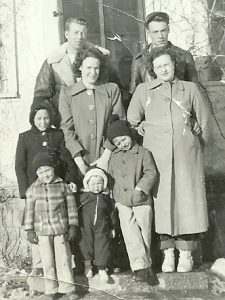 A couple of days ago, we found out that our aunt, Esther Hein had passed away. She was 84 years old. Esther was the eldest of my husband, Bob’s grandmother’s children from her second marriage. I am so sorry to see her go. With her passing, all of Grandma’s children are gone. It is now left to the grandchildren to carry on the legacy Grandma started. Esther had lived much of her adult life in California and Oregon, choosing that milder climate over the harsh Montana winters. Because of where they lived, we didn’t see Esther’s family very often, but she did her best to come for visits to see her parents, Walt and Vina Hein, and siblings Marion Kanta, Walt Schulenberg, Eddie Hein, and Butch Hein and their families in Montana and Wyoming as often as she could manage.
A couple of days ago, we found out that our aunt, Esther Hein had passed away. She was 84 years old. Esther was the eldest of my husband, Bob’s grandmother’s children from her second marriage. I am so sorry to see her go. With her passing, all of Grandma’s children are gone. It is now left to the grandchildren to carry on the legacy Grandma started. Esther had lived much of her adult life in California and Oregon, choosing that milder climate over the harsh Montana winters. Because of where they lived, we didn’t see Esther’s family very often, but she did her best to come for visits to see her parents, Walt and Vina Hein, and siblings Marion Kanta, Walt Schulenberg, Eddie Hein, and Butch Hein and their families in Montana and Wyoming as often as she could manage.
It was on one of her trips to visit her parents, that I first met Esther. It was a good meeting for me, because when I married into the family, my husband Bob asked me to just cut his hair for him. Well, that was a really bad plan. I had never cut a guy’s hair, and it looked awful. His mother had to try to fix it. Ugh!! While we were visiting Grandma and Grandpa, Bob decided to ask Esther to cut his hair. She was trained to do that, so it was a 
 good plan. Esther took pity on me, and she taught me how to cut Bob’s hair. It is a skill that has served me well over the last 50 years, and one for which I will always be thankful to Esther for…as will Bob.
good plan. Esther took pity on me, and she taught me how to cut Bob’s hair. It is a skill that has served me well over the last 50 years, and one for which I will always be thankful to Esther for…as will Bob.
Esther was as skilled seamstress and artist. I remember a set of bathroom curtains she made for my mother-in-law, (her sister-in-law) Joann Schulenberg. She loved them and in her later years, while I was taking care of her when she had Alzheimer’s Disease, she never forgot to tell me about the beautiful curtains that Esther had made for her. My mother-in-law loved Esther dearly. When they were first married, my mother-in-law and father-in-law, Walt Schulenberg often kept Esther at their house in town during the harsh Montana winters, so she wouldn’t miss school, because they couldn’t always get her to town from the ranch. Esther was almost like their own daughter, except that they were too young to have a daughter her age at the time. Esther never forgot how special they were to her, and when she started painting, she painted a landscape picture on a saw 
 blade for her brother, Walt. He cherished it always. She also painted a set of TV trays for him, one of which I have now. Her work was beautiful. While she couldn’t come for visits anymore, she loved keeping in touch with the family, and spoke to my sister-in-law, Debbie Cook on a regular basis. They were very close. My sister-in-law, Brenda Schulenberg also kept her updated by printing out and mailing her many of the family stories from my blog. Esther loved reading all about the younger generation as they grew up. Esther was a beautiful soul, and we are going to miss her very much.
blade for her brother, Walt. He cherished it always. She also painted a set of TV trays for him, one of which I have now. Her work was beautiful. While she couldn’t come for visits anymore, she loved keeping in touch with the family, and spoke to my sister-in-law, Debbie Cook on a regular basis. They were very close. My sister-in-law, Brenda Schulenberg also kept her updated by printing out and mailing her many of the family stories from my blog. Esther loved reading all about the younger generation as they grew up. Esther was a beautiful soul, and we are going to miss her very much.

 My niece, Amanda Reed is one of the most active people I know. She has sports and activities for every season and looks forward excitedly for each new season’s arrival. Amanda’s friends and family make up her circle of influence, and they are a group of people she can count on to be there through thick and thin. In addition, Amanda’s partner, Sean Mortensen and their daughter Jadyn are her very life. These days, Jadyn spends much of her time in Laramie attending the University of Wyoming. It was a big change for Amanda and Sean, but they are very proud of their girl, and very happy for her.
My niece, Amanda Reed is one of the most active people I know. She has sports and activities for every season and looks forward excitedly for each new season’s arrival. Amanda’s friends and family make up her circle of influence, and they are a group of people she can count on to be there through thick and thin. In addition, Amanda’s partner, Sean Mortensen and their daughter Jadyn are her very life. These days, Jadyn spends much of her time in Laramie attending the University of Wyoming. It was a big change for Amanda and Sean, but they are very proud of their girl, and very happy for her.
Amanda is in the middle of a long career in banking. She began her career when she went to work at the 
 Rawlins National Bank at a young age. Since that time, she has worked her way up to the pretty prestigious position of BSA Agent, which is a part of the law enforcement area of the bank. It is strange to think of Amanda in “law enforcement” and while it isn’t the normal type, it is law enforcement, nevertheless. Her work is in deterring fraud, money laundering, and such. I don’t claim to know all she does, but I know that it is an important part of the banking system. Counterfeit money and other types of fraud cost everyone in the end, Amanda works to stop this, and that is good for everyone.
Rawlins National Bank at a young age. Since that time, she has worked her way up to the pretty prestigious position of BSA Agent, which is a part of the law enforcement area of the bank. It is strange to think of Amanda in “law enforcement” and while it isn’t the normal type, it is law enforcement, nevertheless. Her work is in deterring fraud, money laundering, and such. I don’t claim to know all she does, but I know that it is an important part of the banking system. Counterfeit money and other types of fraud cost everyone in the end, Amanda works to stop this, and that is good for everyone.
As Summer approaches, I’m sure Amanda and her “gang” will be gearing up for the next season of great 
 weekend fun. They love boating, skiing, jet skis, fishing, and hanging out with great friends. While Winter is great for snow sports, they look forward to summer fun too. When these guys get together, they know it’s going to be a great time. These friends have been friends for a long time, and they all have similar likes. There is never a dull moment. Amanda is very blessed with the people she surrounds herself with. Today is Amanda’s birthday. Happy birthday Amanda!! Have a great day!! We love you!!
weekend fun. They love boating, skiing, jet skis, fishing, and hanging out with great friends. While Winter is great for snow sports, they look forward to summer fun too. When these guys get together, they know it’s going to be a great time. These friends have been friends for a long time, and they all have similar likes. There is never a dull moment. Amanda is very blessed with the people she surrounds herself with. Today is Amanda’s birthday. Happy birthday Amanda!! Have a great day!! We love you!!


